Proceeding
from the differences in linguistic signs we claim that word-signs be
subdivided into two principal groups: lexical words and grammatical
words.
Lexical
words
are the linguistic signs which possess denotative
ability. They are denotators of extralingual objects and phenomena,
objective and subjective: a
window, a country, to judge,
etc. Their function consists in nominating or designating the denoted
objects and phenomena. The nominative character of denotative words,
which correlate with notions and have full denotative content, helps
to distinguish
nominative
words
from
non-nominative ones. Lexical
words in contrast to “grammatical words’’are nominative units
which function as lingual nominators of denoted referents.
The
term “notional”, however acceptable it might be, is not probably
exact because, in fact, all words, this way or another, correlate
with notions. But the correlative notions may be different, and the
ways of correlation may differ too. The term seems somewhat
misleading. Grammar resorts to it but interprets it conventionally as
a designation of denotative units only.
Grammatical
words are
also linguistic signs but they possess significative ability.
They
are
significators of general conceptual notions.
They
do not designate or nominate them as the word “significate”
itself
does.
They
may or may not have reference to objective reality.If they have any,
grammatical words are said to possess certain referential and
reflective ability. The significative character of the main stock of
grammatical words is obvious. This results from their function of
signification, i.e. the representation of general conceptual notions
(categories) not in the way of nominating but by signifying or
marking them grammatically. Hence, it is the way of lingual
representation and the nature of conceptual referents, significative
generic notions or categories, that predetermine the specific
lingual function of signification. Nomination and signification
are correlative and distinctive they lie at the basis of
differentiating lexical words from grammatical ones.
Since
grammatical words are devoid of nominative power they can be
characteristically qualified as “function-words”, i. e. words
attributed with particular functional design such as to signify
conceptual categories, to form up language units in their
function and relationships or to provide orientation in speech
situations. The functionality of grammatical words makes it
necessary to regard them together with other grammatical devices of
linguistic means of expression. Both types of words are bilateral
entities having their content and expression sides.
The
notion of ‘grammatical meaning’.
The word
combines in its semantic structure two meanings – lexical and
grammatical. Lexical
meaning
is the individual meaning of the word (e.g. table).
Grammatical
meaning
is the meaning of the whole class or a subclass. For example, the
class of nouns has the grammatical meaning of thingness.
If we take a noun (table)
we may say that it possesses its individual lexical meaning (it
corresponds to a definite piece of furniture) and the grammatical
meaning of thingness
(this is the meaning of the whole class). Besides, the noun ‘table’
has the grammatical meaning of a subclass – countableness.
Any verb combines its individual lexical meaning with the grammatical
meaning of verbiality – the ability to denote actions or states. An
adjective combines its individual lexical meaning with the
grammatical meaning of the whole class of adjectives –
qualitativeness – the ability to denote qualities. Adverbs possess
the grammatical meaning of adverbiality – the ability to denote
quality of qualities.
There are some classes of
words that are devoid of any lexical meaning and possess the
grammatical meaning only. This can be explained by the fact that they
have no referents in the objective reality. All function words belong
to this group – articles, particles, prepositions, etc.
Types of grammatical
meaning.
The
grammatical meaning may be explicit and implicit. The implicit
grammatical
meaning is not expressed formally (e.g. the word table
does
not contain any hints in its form as to it being inanimate). The
explicit
grammatical
meaning is always marked morphologically – it has its marker. In
the word cats
the
grammatical meaning of plurality is shown in the form of the noun;
cat’s
–
here the grammatical meaning of possessiveness is shown by the form
‘s;
is
asked –
shows the explicit grammatical meaning of passiveness.
The
implicit grammatical meaning may be of two types – general and
dependent. The general
grammatical meaning is the meaning of the whole word-class, of a part
of speech (e.g. nouns – the general grammatical meaning of
thingness). The dependent
grammatical meaning is the meaning of a subclass within the same part
of speech. For instance, any verb possesses the dependent grammatical
meaning of transitivity/intransitivity,
terminativeness/non-terminativeness, stativeness/non-stativeness;
nouns have the dependent grammatical meaning of
contableness/uncountableness and animateness/inanimateness. The most
important thing about the dependent grammatical meaning is that it
influences the realization of grammatical categories restricting them
to a subclass. Thus the dependent grammatical meaning of
countableness/uncountableness influences the realization of the
grammatical category of number as the number category is realized
only within the subclass of countable nouns, the grammatical meaning
of animateness/inanimateness influences the realization of the
grammatical category of case, teminativeness/non-terminativeness —
the category of tense, transitivity/intransitivity – the category
of voice.
GRAMMATICAL
MEANING
EXPLICIT
IMPLICIT
GENERAL
DEPENDENT
Соседние файлы в предмете [НЕСОРТИРОВАННОЕ]
- #
- #
- #
- #
- #
- #
- #
- #
- #
- #
- #
From Wikipedia, the free encyclopedia
|
|
Parts of this article (those related to work since the 2000s) need to be updated. Please help update this article to reflect recent events or newly available information. (July 2019) |
In linguistics, the lexical aspect or Aktionsart (German pronunciation: [ʔakˈtsi̯oːnsˌʔaʁt], plural Aktionsarten [ʔakˈtsi̯oːnsˌʔaɐ̯tn̩]) of a verb is part of the way in which that verb is structured in relation to time. For example, the English verbs arrive and run differ in their lexical aspect since the former describes an event which has a natural endpoint while the latter does not. Lexical aspect differs from grammatical aspect in that it is an inherent semantic property of a predicate, while grammatical aspect is a syntactic or morphological property. Although lexical aspect need not be marked morphologically, it has downstream grammatical effects, for instance that arrive can be modified by «in an hour» while believe cannot.
Theories of aspectual class[edit]
Although all theories of lexical aspect recognize that verbs divide into different classes, the details of the classification differ. An early attempt by Vendler recognized four classes, which has been modified several times.
Vendler’s classification[edit]
Zeno Vendler classified verbs into four categories on whether they express «activity», «accomplishment», «achievement» or «state». Activities and accomplishments are distinguished from achievements and states in that the first two allow the use of continuous and progressive aspects. Activities and accomplishments are distinguished from each other by boundedness. Activities do not have a terminal point (a point before which the activity has taken place and after which cannot continue: «John drew a circle»), but accomplishments have one. Of achievements and states, achievements are instantaneous, but states are durative. Achievements and accomplishments are distinguished from one another in that achievements take place immediately (such as in «recognise» or «find»), but accomplishments approach an endpoint incrementally (as in «paint a picture» or «build a house»).[1][2]
Comrie’s classification[edit]
In his discussion of lexical aspect, Bernard Comrie included the category semelfactive or punctual events such as «sneeze». His divisions of the categories were as follows: states, activities, and accomplishments are durative, but semelfactives and achievements are punctual. Of the durative verbs, states are unique as they involve no change, and activities are atelic (that is, have no «terminal point») whereas accomplishments are telic. Of the punctual verbs, semelfactives are atelic, and achievements are telic. The following table shows examples of lexical aspect in English that involve change (an example of a state is ‘know’).[1][3]
| Punctual | Durative | |
|---|---|---|
| Telic | Achievement (to release) |
Accomplishment (to drown) |
| Atelic | Semelfactive (to knock) |
Activity (to walk) |
| Static | State (to know) |
Moens and Steedman’s classification[edit]
Another classification is proposed by Moens and Steedman, based on the idea of the event nucleus[4]
| Event nucleus | |||
|---|---|---|---|
| Preparatory
phase |
Culminating
event |
Consequent
phase |
|
| Semelfactive | |||
| State | |||
| Activity | |||
| Achievement | |||
| Accomplishment |
Syntactic analyses of event structure[edit]
Aspectual classes can be analyzed as differing in their event structure, and this has led to the development of syntactic analyses of event structure, with each aspectual class treated as having a distinct syntactic structure.
See also[edit]
- Predicate
- Syntax–semantics interface
References[edit]
- ^ a b Rothstein, Susan (2016). «Aspect». In Aloni, Maria; Dekker, Paul (eds.). Cambridge Handbook of Formal Semantics. Cambridge University Press. ISBN 978-1-107-02839-5.
- ^ Vendler, Zeno (1957). «Verbs and Times» (PDF). The Philosophical Review. 66 (2): 143–160. doi:10.2307/2182371. JSTOR 2182371.
- ^ Comrie, Bernard (1976). Aspect: An Introduction to the Study of Verbal Aspect and Related Problems. Cambridge Textbooks in Linguistics. Cambridge University Press. ISBN 9784838401000.
- ^ Moens, Marc; Steedman, Mark (1988). «Temporal ontology and temporal reference» (PDF). Computational Linguistics. Association for Computational Linguistics. 14 (2): 15–28. ISSN 0362-613X.
Слайд 1Aspects of Lexical Meaning
Lecture
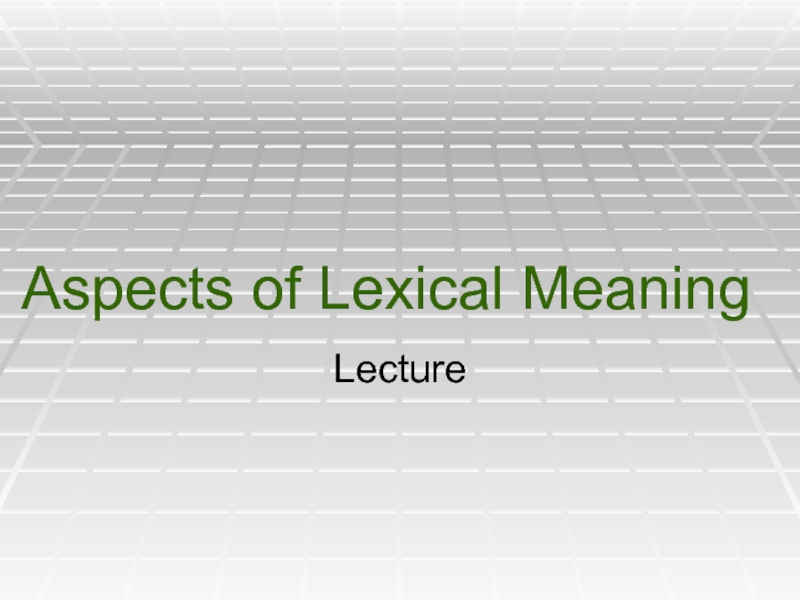
Слайд 2ASPECTS OF LEXICAL MEANING
THE DENOTATIONAL ASPECT
THE CONNOTATIONAL ASPECT
THE PRAGMATIC ASPECT
COMPONENTIAL ANALYSIS
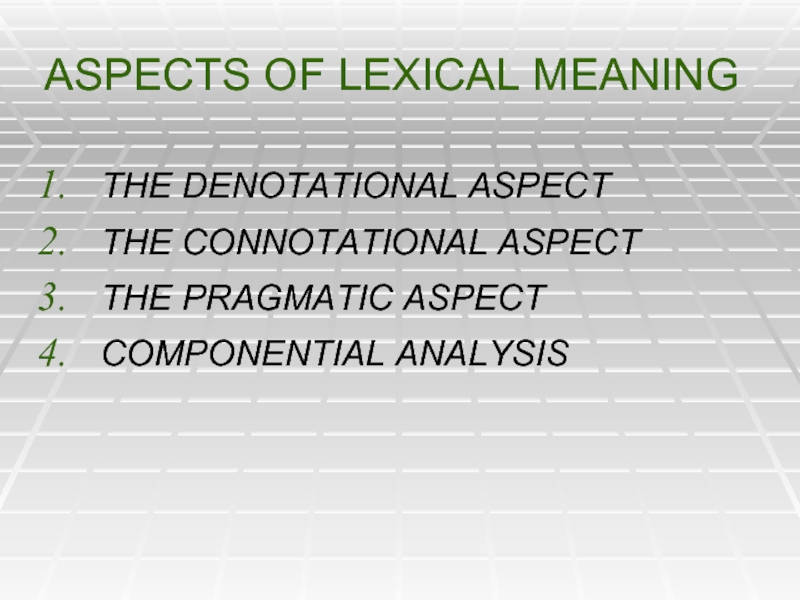
Слайд 31. THE DENOTATIONAL ASPECT
The denotational aspect of lexical meaning is the
part of lexical meaning which establishes correlation between the name and the object, phenomenon, process or characteristic feature of concrete reality (or thought), which is denoted by the given word.
e.g. booklet — ‘a small thin book that gives information about something’
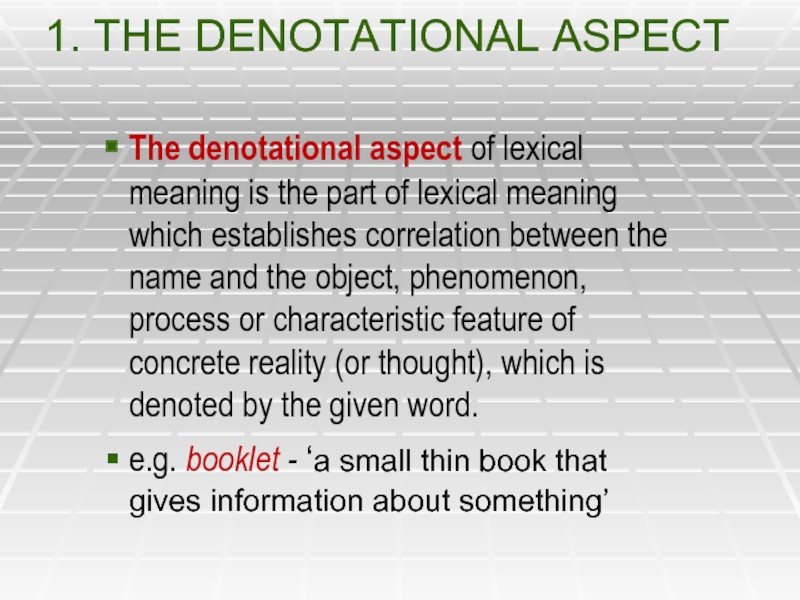
Слайд 4Through the denotational aspect of meaning the bulk of information is
conveyed in the process of communication.
The denotational aspect of lexical meaning:
expresses the notional content of a word.
is the component of the lexical meaning that makes communication possible.
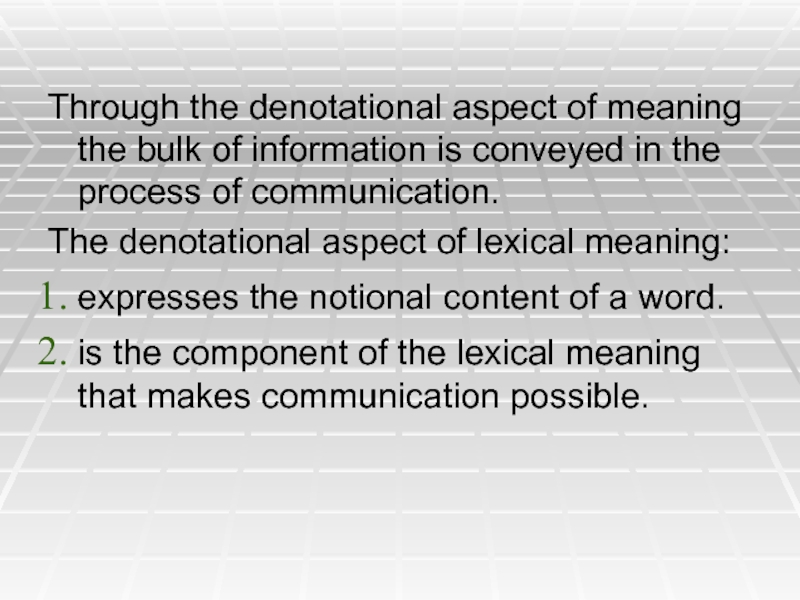
Слайд 52. THE CONNOTATIONAL ASPECT
The connotational aspect of lexical meaning is the
part of meaning which reflects the attitude of the speaker towards what he speaks about. Connotation conveys additional information in the process of communication.
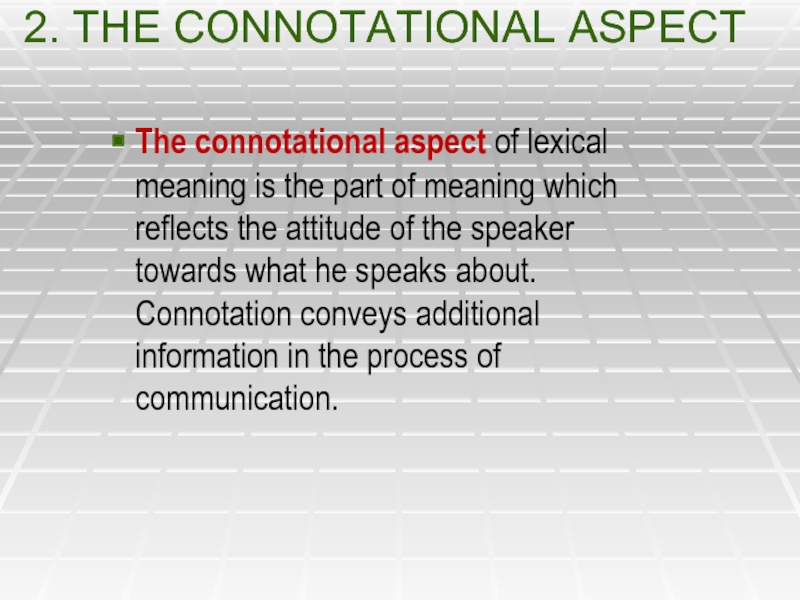
Слайд 6Connotation includes:
The emotive charge is one of the objective semantic features
proper to words as linguistic units and forms part of the connotational component of meaning, e.g. daddy as compared to father.
a hovel – ‘a small house or cottage’ – implies a miserable dwelling place, dirty, in bad repair and in general unpleasant to live in.
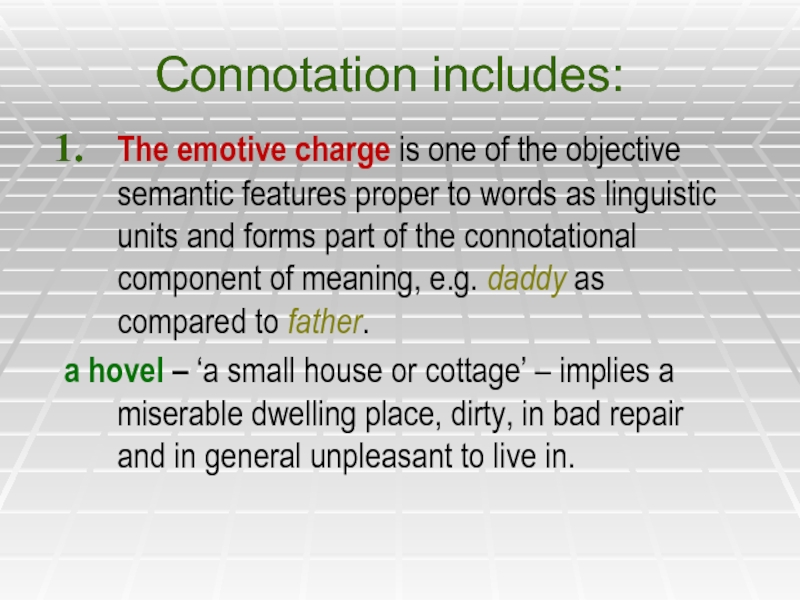
Слайд 8Evaluation, which may be positive or negative, e.g.
clique (a small
group of people who seem unfriendly to other people) as compared to group (a set of people);
celebrated (widely known for special achievement in science, art, sport, etc.) as compared to notorious (widely known for criminal act or bad traits of character).
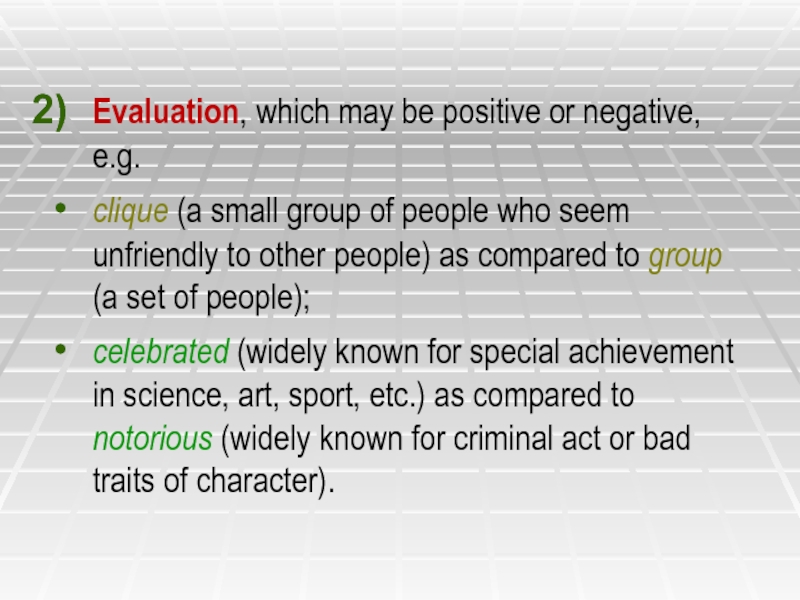
Слайд 9Imagery:
to wade – to walk with an effort (through mud,
water or anything that makes progress difficult). The figurative use of the word gives rise to another meaning, which is based on the same image as the first – to wade through a book ;
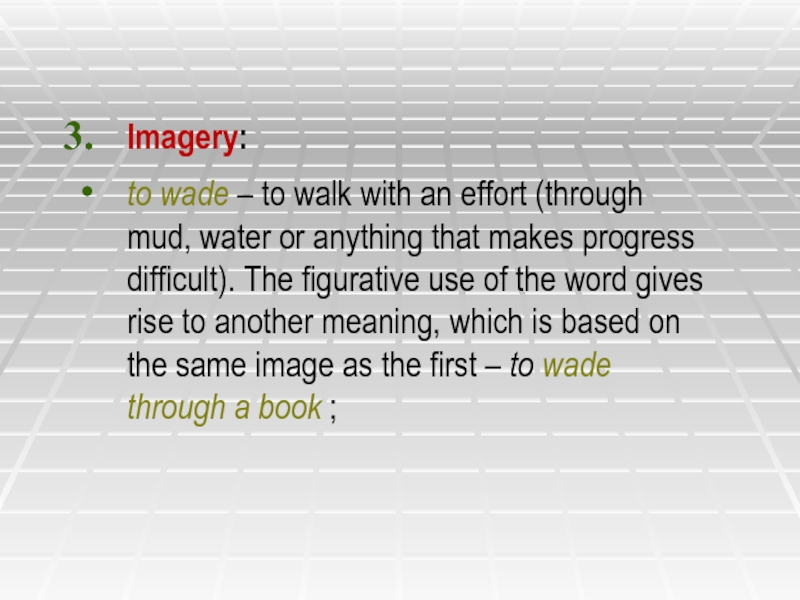
Слайд 10intensity/expressiveness, e.g. to adore – to worship – to love –
to like;
connotation of cause, duration etc.
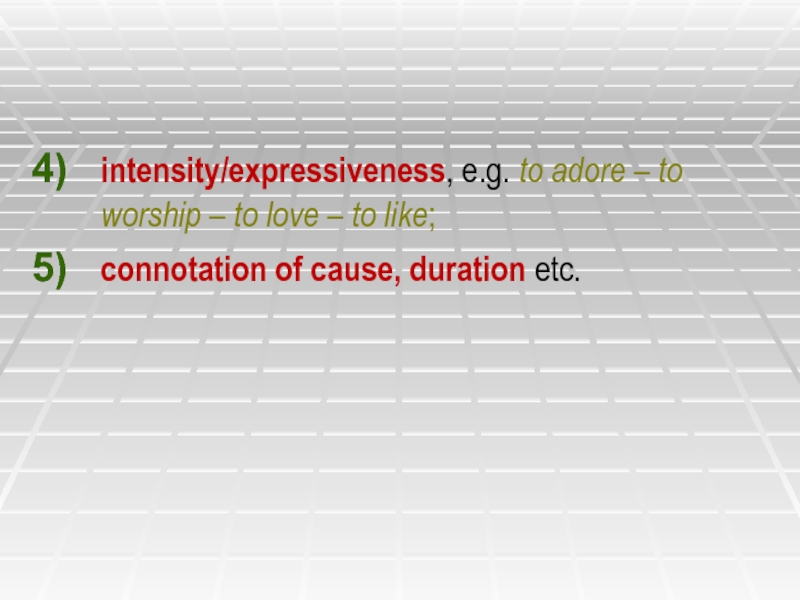
Слайд 14Thus, a meaning can have two or more connotational components.
The given
examples present only a few: emotive, evaluative connotations, and also connotations of duration and of cause.
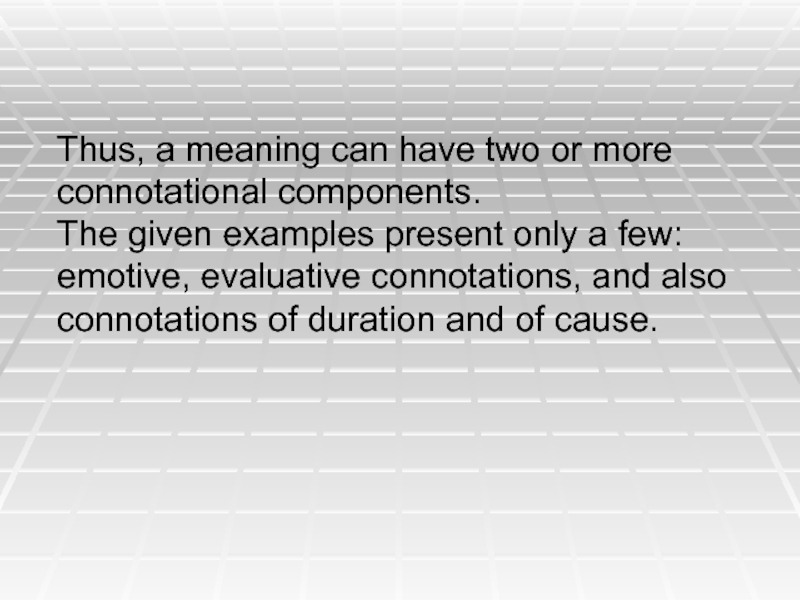
Слайд 153. Examples of different types of Connotation
I. The connotation of degree
or intensity
to surprise — to astonish — to amaze — to astound;
to satisfy — to please — to content — to gratify — to delight — to exalt;
to shout — to yell — to bellow — to roar; to like — to admire — to love — to adore — to worship
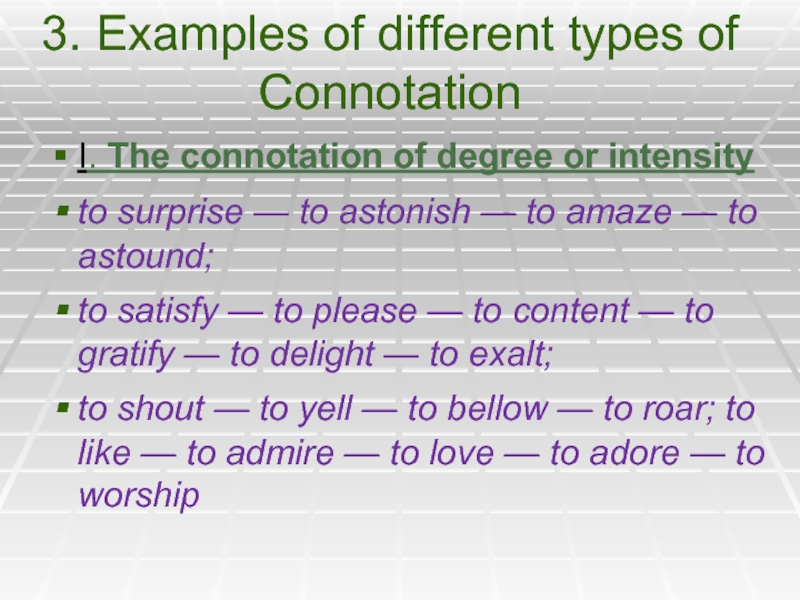
Слайд 16II. Connotation of duration
to stare — to glare — to gaze
— to glance — to peep — to peer;
to flash (brief) — to blaze (lasting);
to shudder (brief) — to shiver (lasting);
to say (brief) — to speak, to talk (lasting).
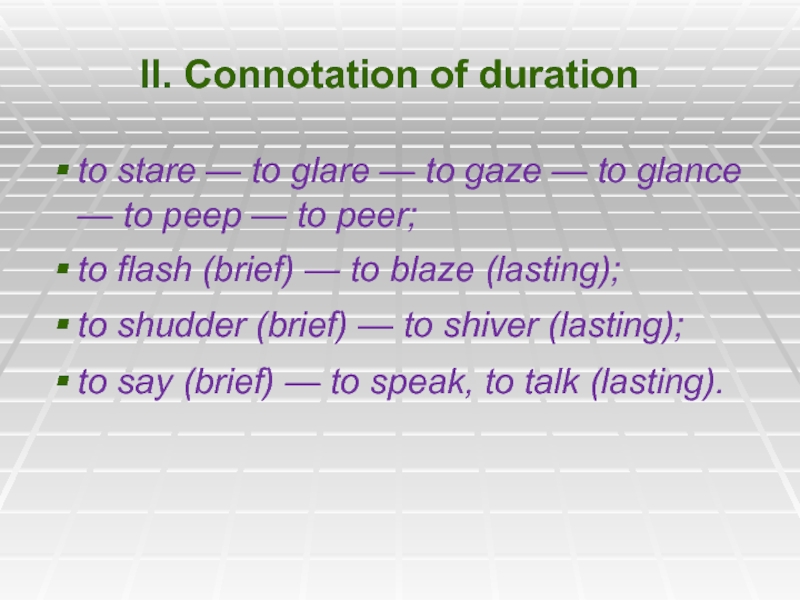
Слайд 17III. Emotive connotations
to stare — to glare — to gaze;
alone —
single — lonely — solitary;
to tremble — to shiver — to shudder — to shake;
to love — to admire — to adore — to worship;
angry — furious — enraged;
fear — terror — horror.
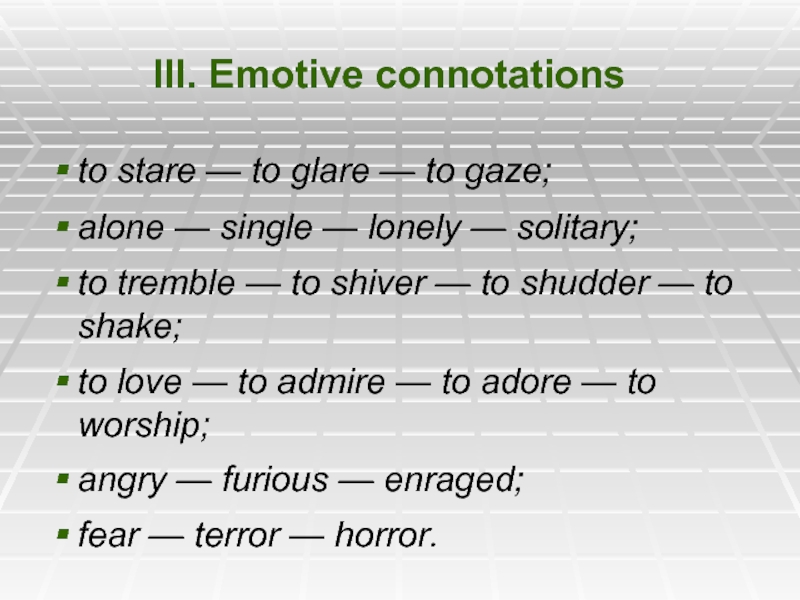
Слайд 18IV. The evaluative connotation
well-known — famous — notorious — celebrated;
to produce
— to create — to manufacture — to fabricate;
to sparkle — to glitter;
A. His (her) eyes sparkled with amusement, merriment, good humour, high spirits, happiness, etc. (positive emotions).
B. His (her) eyes glittered with anger, rage, hatred,
malice, etc. (negative emotions).
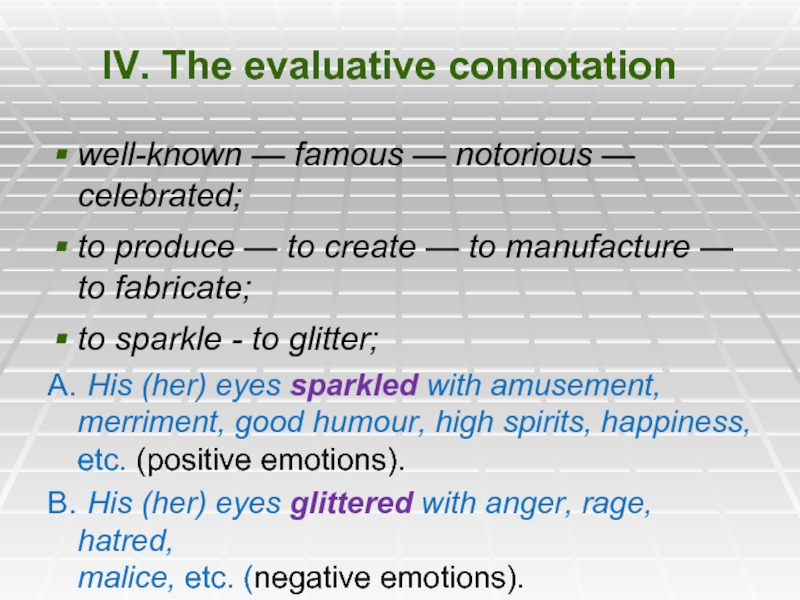
Слайд 19V. Causative connotation
to sparkle — to glitter;
to shiver — to shudder;
to
blush — to redden.
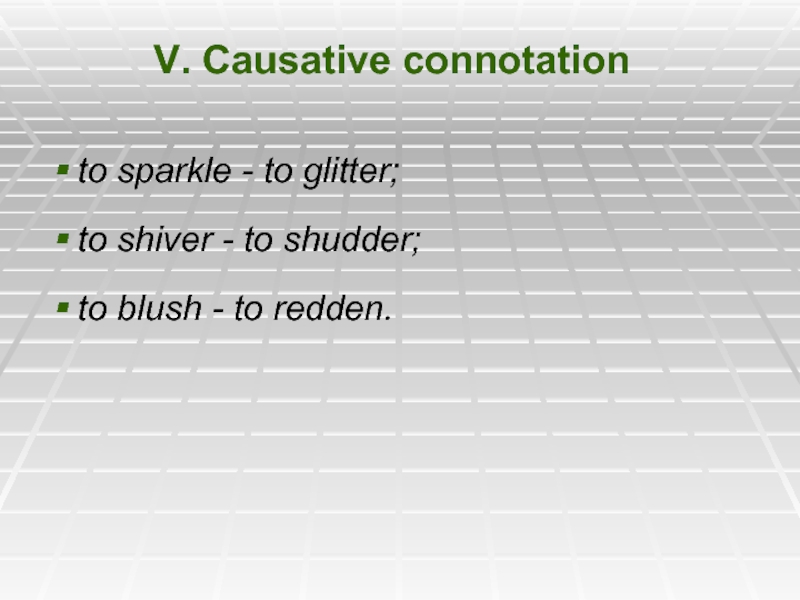
Слайд 20VI. Connotation of Manner
to stroll — to stride — to trot
— to pace — to swagger — to stagger — to stumble;
to peep — to peer;
to like — to admire — to love — to adore — to worship.
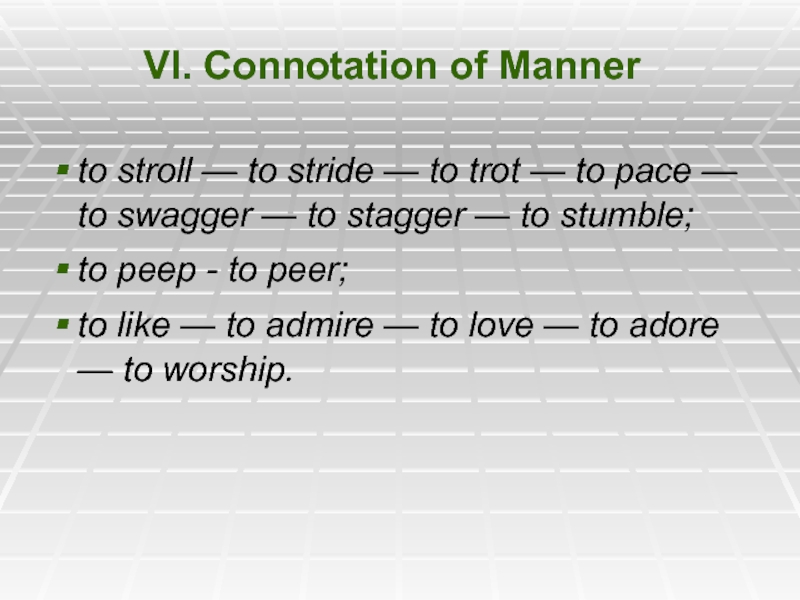
Слайд 21VII. The connotation of attendant circumstances
One peeps at smb./smth. through a
hole, crack or opening, from behind a screen, a half-closed door, a newspaper, a fan, a curtain, etc. It seems as if a whole set of scenery were built within the word’s meaning. It is not quite so, because «the set of scenery» is actually built in the context, but, as with all regular contexts, it is intimately reflected in the word’s semantic structure.
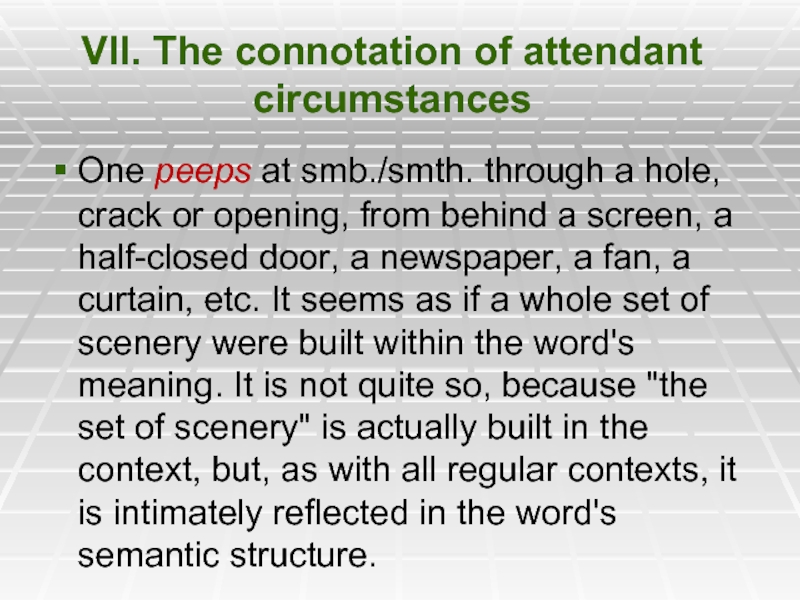
Слайд 22One peers at smb./smth. in darkness, through the fog, through dimmed
glasses or windows, from a great distance; a short-sighted person may also peer at things. So, in the semantic structure of to peer are encoded circumstances preventing one from seeing clearly.
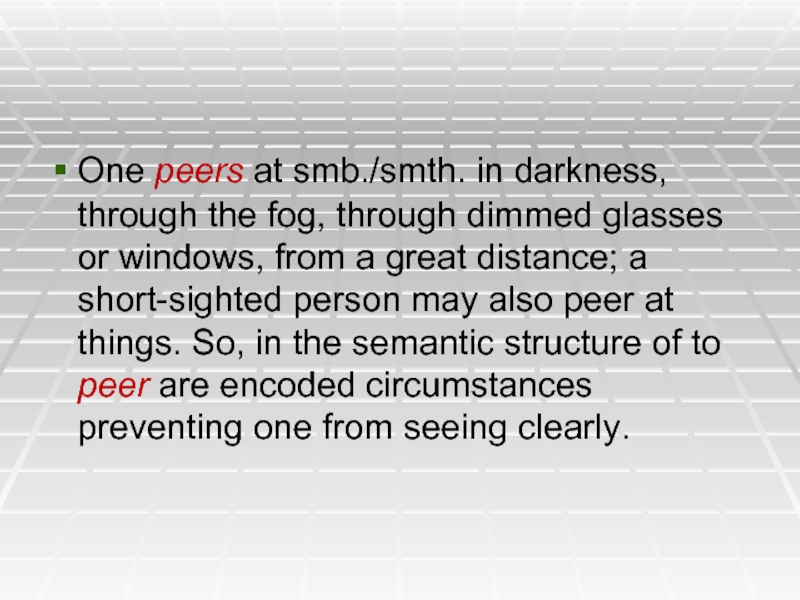
Слайд 23VII. Connotation of attendant features
Pretty – handsome – beautiful;
special types
of human beauty:
beautiful is mostly associated with classical features and a perfect figure;
handsome with a tall stature, a certain robustness and fine proportions,
pretty with small delicate features and a fresh complexion.
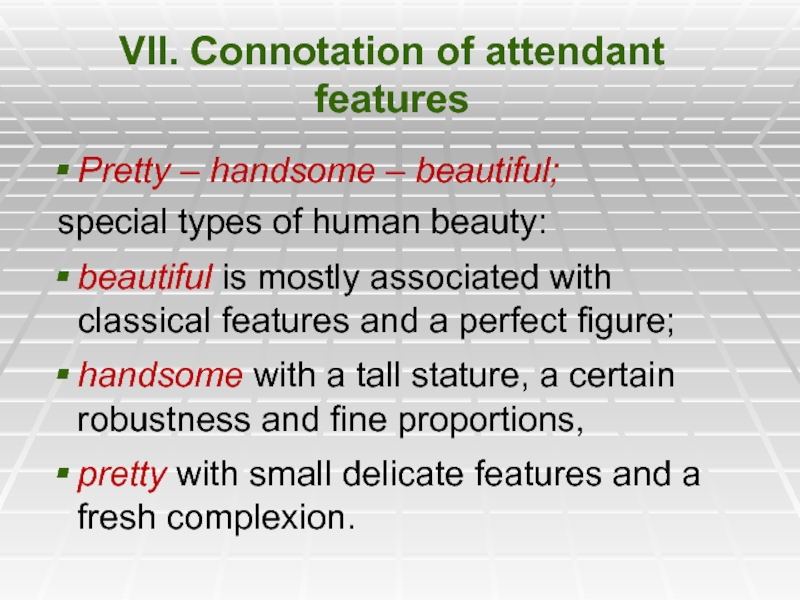
Слайд 24IX. Stylistic connotations
(Meal). Snack, bite (coll.), snap (dial.), repast, refreshment, feast
(formal).
These synonyms, besides stylistic connotations, have connotations of attendant features.
Snack, bite, snap all denote a frugal meal taken in a hurry; refreshment is also a light meal; feast is a rich or abundant meal.
(Girl). Girlie (coll.), lass, lassie (dial.), bird, birdie, jane, fluff, skirt (sl.), maiden (poet.), damsel (arch.).
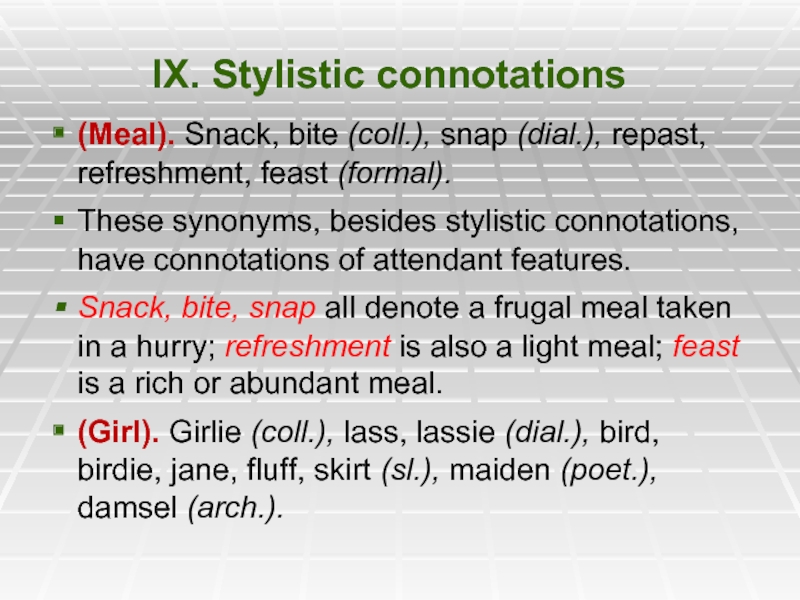
Слайд 25Anecdote
J a n e: Would you be insulted if that
good-looking stranger offered you some champagne?
J o a n: Yes, but I’d probably swallow the insult.
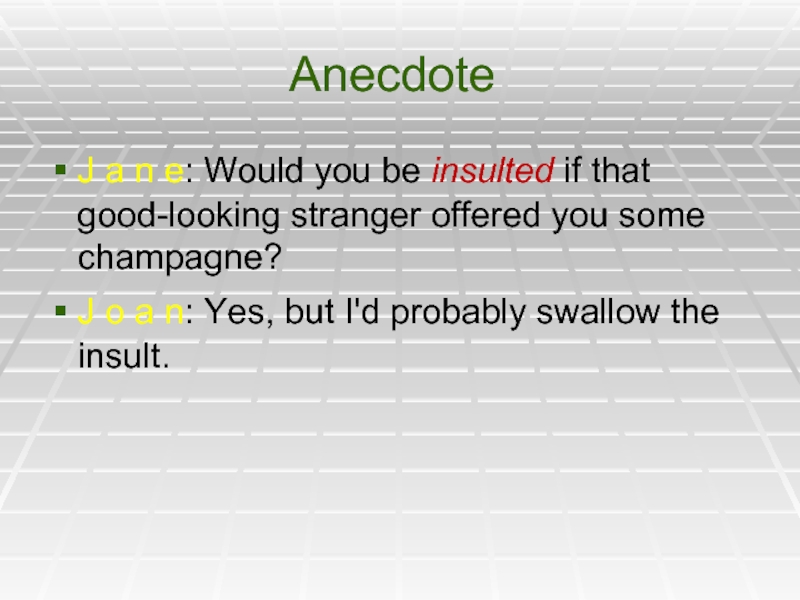
Слайд 263. THE PRAGMATIC ASPECT
The pragmatic aspect is the part of lexical
meaning that conveys information on the situation of communication. Like the connotational aspect, the pragmatic aspect falls into four closely linked together subsections.
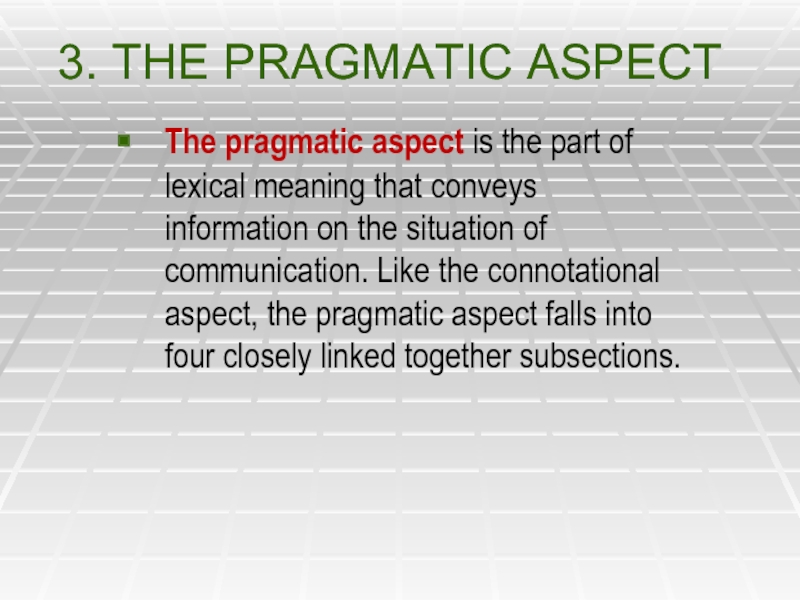
Слайд 27
1. Information on the ‘time and space’ relationship of the participants
Some
information which specifies different parameters of communication may be conveyed not only with the help of grammatical means (tense forms, personal pronouns, etc), but through the meaning of the word.
E.g. come and go can indicate the location of the speaker who is usually taken as the zero point in the description of the situation of communication
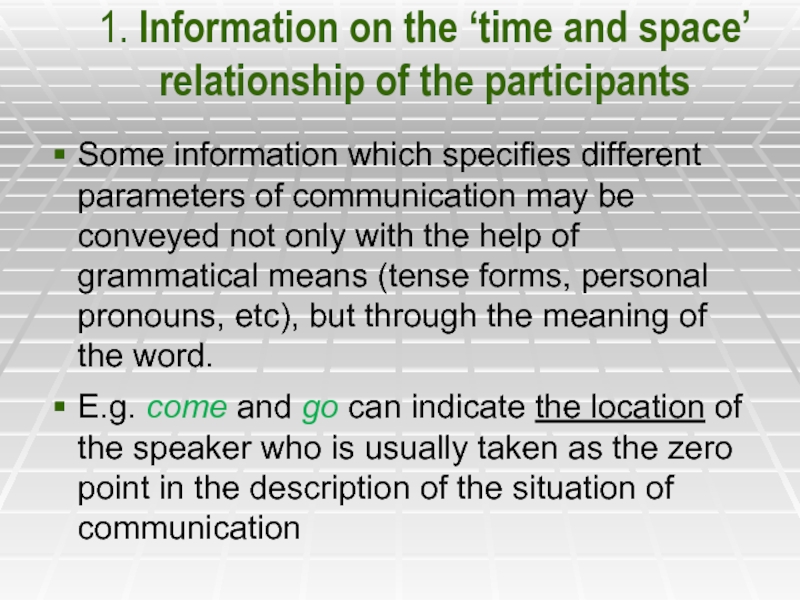
Слайд 28The time element is fixed indirectly. Indirect reference to time implies
that the frequency of occurrence of words may change with time and in extreme cases words may be out of use or become obsolete.
E.g.the word behold – ‘take notice, see (smth unusual)’ as well as the noun beholder – ‘spectator’ are out of use now but were widely used in the 17th century.
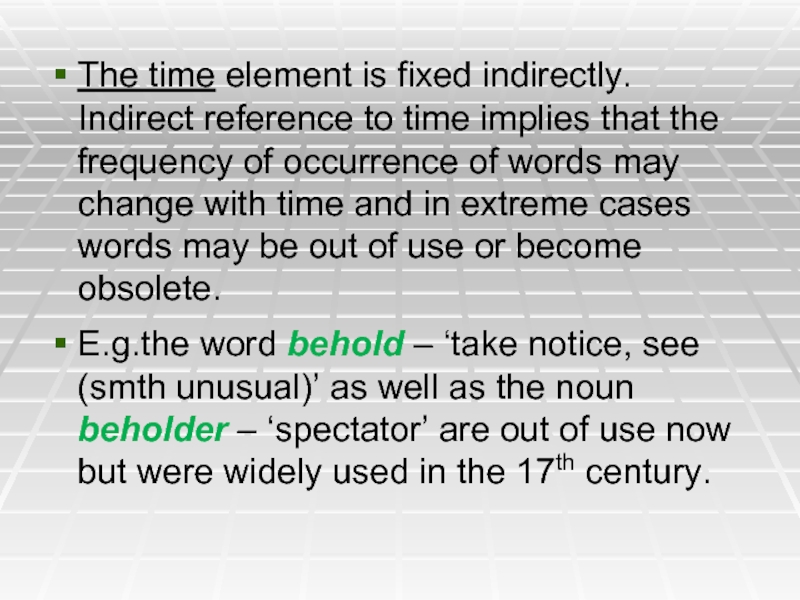
Слайд 292. Information on the participants and the given language community;
The language
used may be indicative of the social status of a person, his education, profession, etc.
The pragmatic aspect of the word may convey information about the social system of the given language community, its ideology, religion, system of norms and customs.
a) They chucked a stone at the cops, and then did a bunk with the loot.
b) After casting a stone at the police, they absconded with the money.
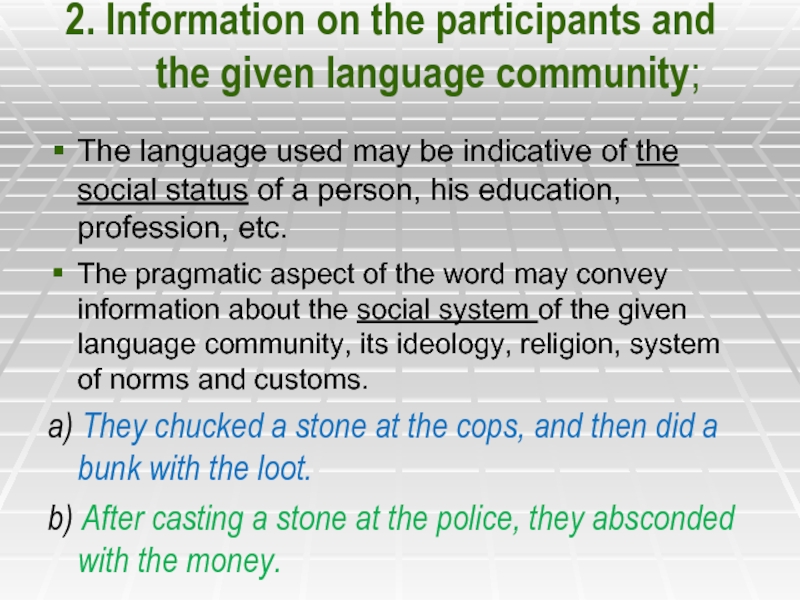
Слайд 303. Information on the tenor of discourse
The tenors of discourse reflect
how the addresser (the speaker or the writer) interacts with the addressee (the listener or reader).
Tenors are based on social or family roles of the participants of communication.
1. Don’t interrupt when your mother is speaking (family roles).
2. There is an awful man in the front row, who butts in whenever you pause (social roles).
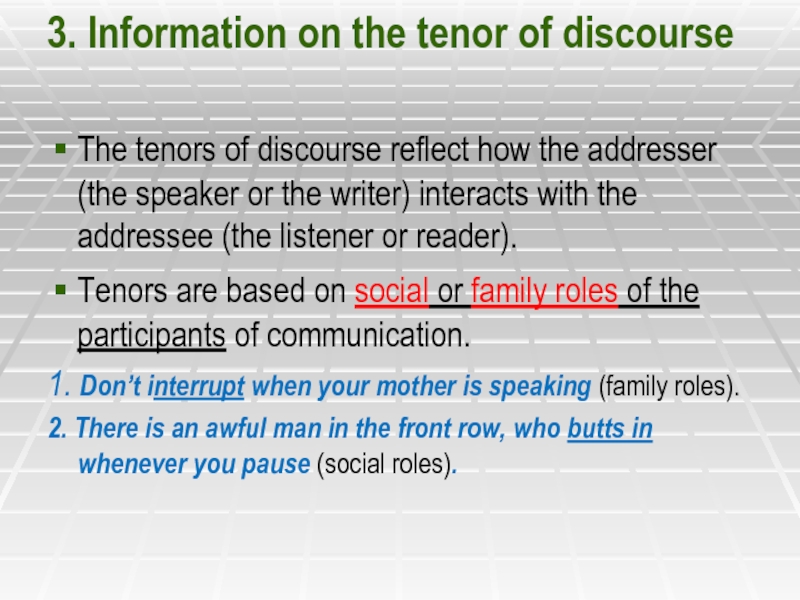
Слайд 314. Information on the register of communication
The conditions of
communication form another important group of factors. The register defines the general type of the situation of communication grading the situations in formality. Three main types of the situations of communication: formal, neutral and informal.
I’m sorry if upset you, dear. I certainly didn’t mean to (informal).
There are certain qualities in his works that I greatly admire (formal).
Who is the girl I saw you with yesterday? (neutral).

Слайд 32LEXICAL MEANING
Denotational Connotational Pragmatic aspect
aspect aspect
Emotive charge
Evaluation
Imagery
Intensity
Connotation
Information on the
‘time and space’
Information on the participants and
the givenlanguage community
Information on the tenor of discourse
Information on the register of communication
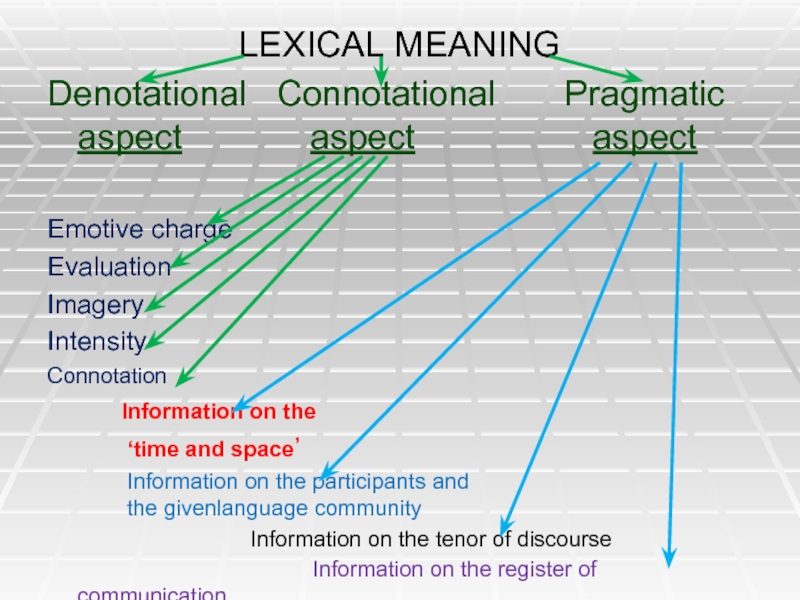
Слайд 33IV. Componential analysis = semantic decomposition
rests upon the thesis that
the sense of every lexeme can be analyzed in terms of a set of more general sense components or semantic features, some or all of which will be common to several different lexemes in the vocabulary.
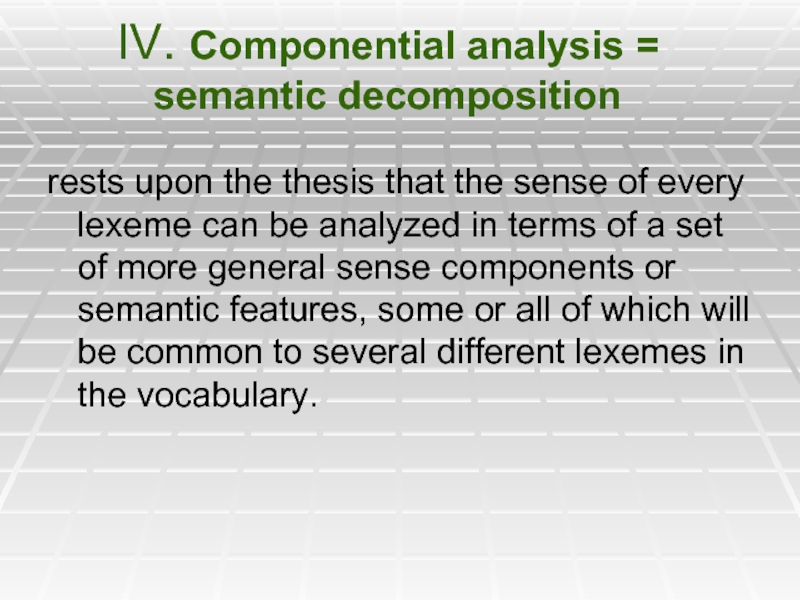
Слайд 34Componential analysis
attempts to treat components according to ‘binary’ opposition:
male/
female,
animate/ inanimate,
adult/ non-adult,
human/ non-human.
The sense of man might be held to combine the concepts (male, adult, human).
The sense of woman might be held to differ from man in that it combines (female (not male), adult, human).
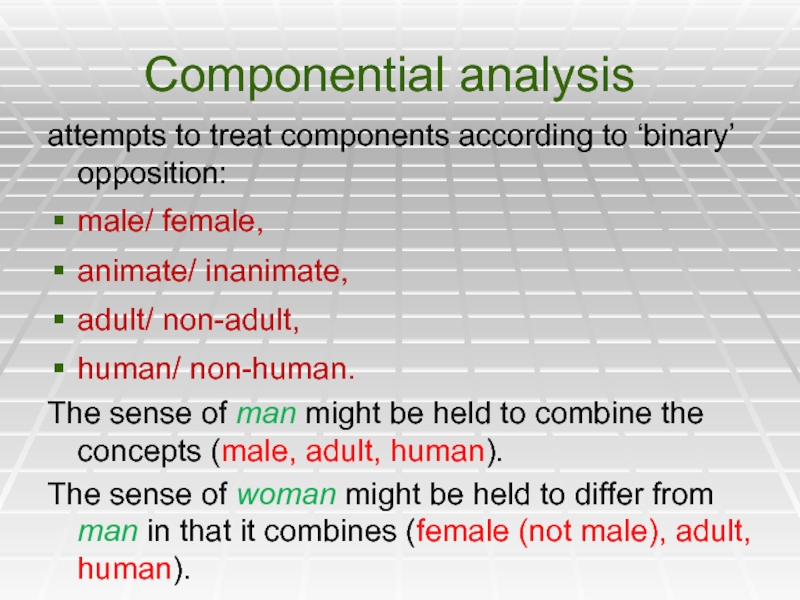
Слайд 35Componential analysis allows us to group entities into natural classes.
man
and boy (human, male),
man and woman (human, adult).
There are certain verbs, such as marry, argue, that are found with subjects that are [+human]. Moreover, within the English pronoun system, he is used to refer to [human] entities that are [+male] while she is used for [human] entities that are [not male].
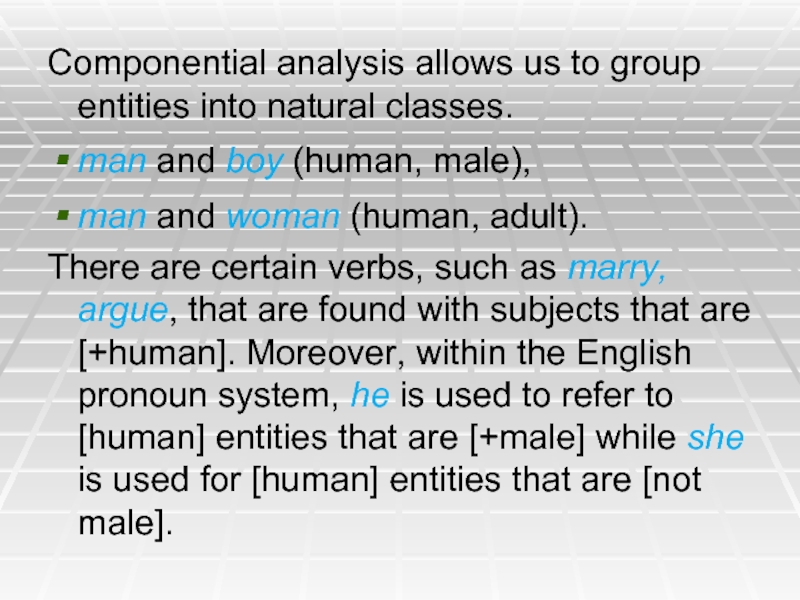
Слайд 36Componential analysis of the word ‘bachelor’
According to the dictionary it has
4 meanings:
a man who has never married (холостяк);
a young knight (рыцарь);
someone with a first degree (бакалавр);
a young male unmated fur seal (морской котик) during the mating season.
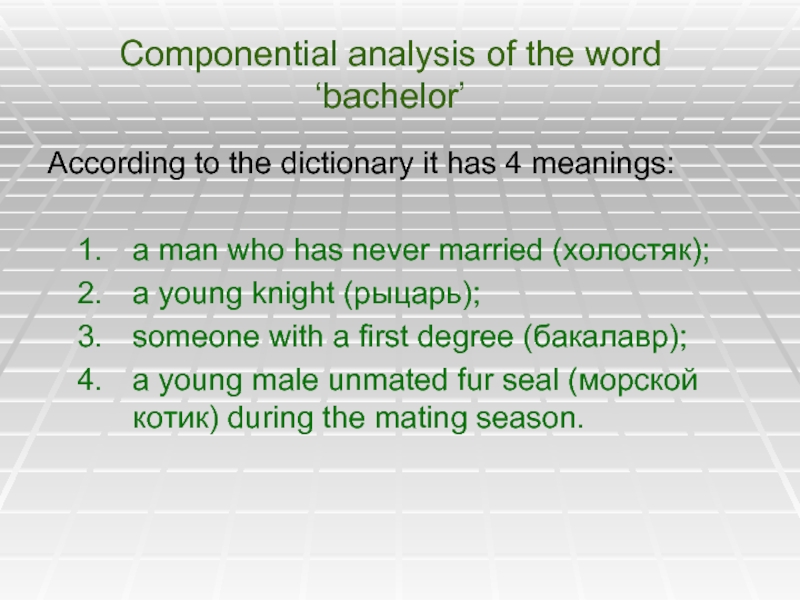
Слайд 37Bachelor
Noun
(Human) (Animal)
(Male) [who has the first of (Male)
lowest academic degree]
[who has [young knight serving [young fur seal when
never married] under the standard of without a mate during
another knight] the breeding time]
[who has never [young knight serving [young fur seal when
married] under the standard of without a mate during
another knight] the breeding time]
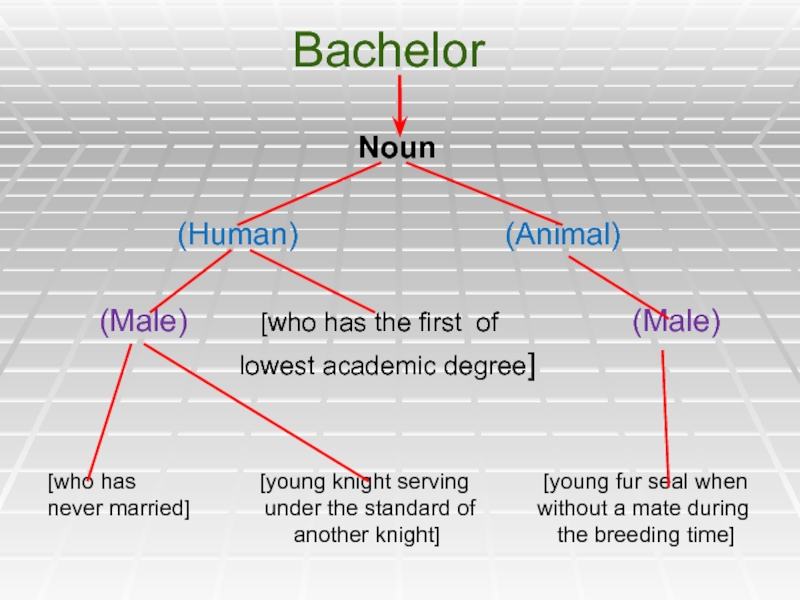
Слайд 38The old bachelor finally died.
‘Bachelor’ is not the fur
seal (they are young).
(young) => is a marker not the distinguisher.
Theoretically there is no limit to the number of markers.
Markers refer to the features which the lexeme has in common with other lexical items,
a distinguisher differentiates it from all other items.
Distinguishers can be regarded as providing a denotational distinction, while semantic markers represent conceptual components of the meaning of lexical items.
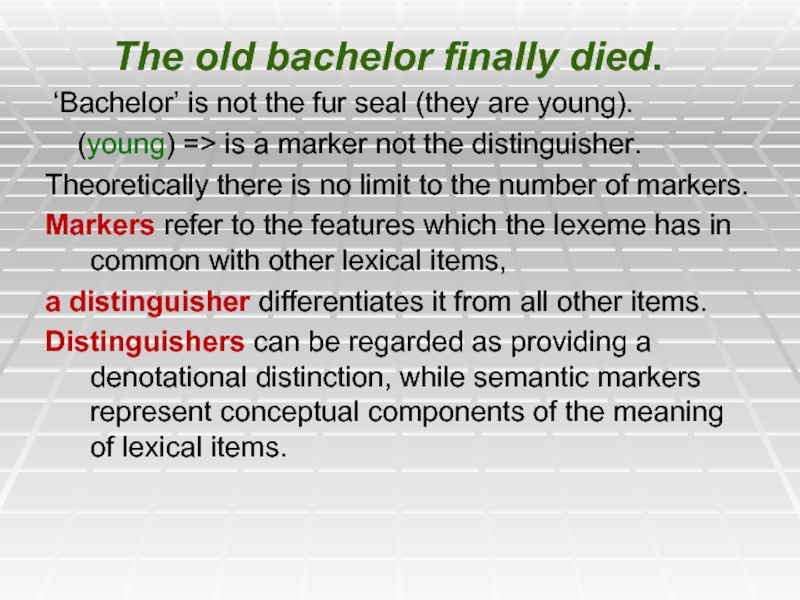
Слайд 39Componential analysis
gives its most important results in the study
of verb meaning, it is an attractive way of handling semantic relations. It is currently combined with other linguistic procedures used for the investigation of meaning.
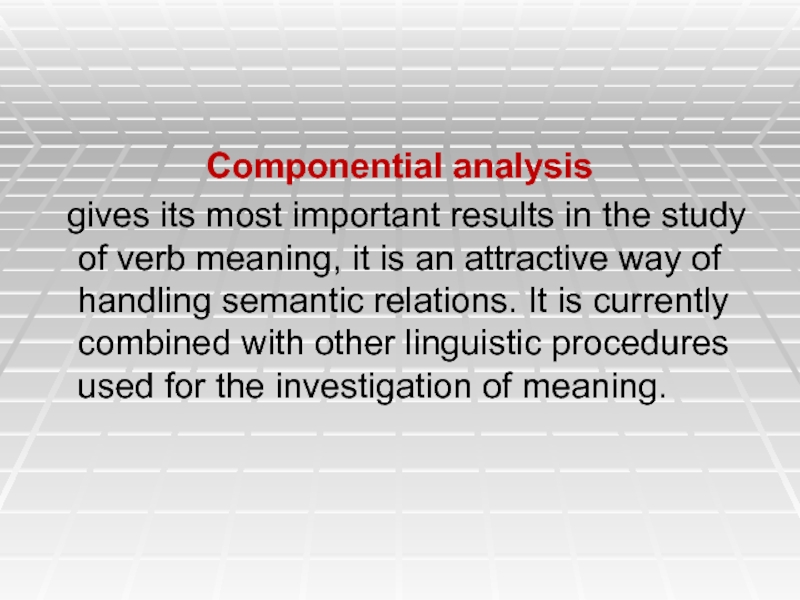
Слайд 40References:
Зыкова И.В. Практический курс английской лексикологии. М.: Академия, 2006. – С.-
18-21.
Гинзбург Р.З. Лексикология английского языка. М.: Высшая школа, 1979. – С.- 20-22.
Бабич Н.Г. Лексикология английского языка. Екатеринбург-Москва. 2006. – С.- 61- 62.
Антрушина Г.Б., Афанасьева О.В., Морозова Н.Н. Лексикология английского языка. М.; Дрофа, 2006. С. — 136-142.





